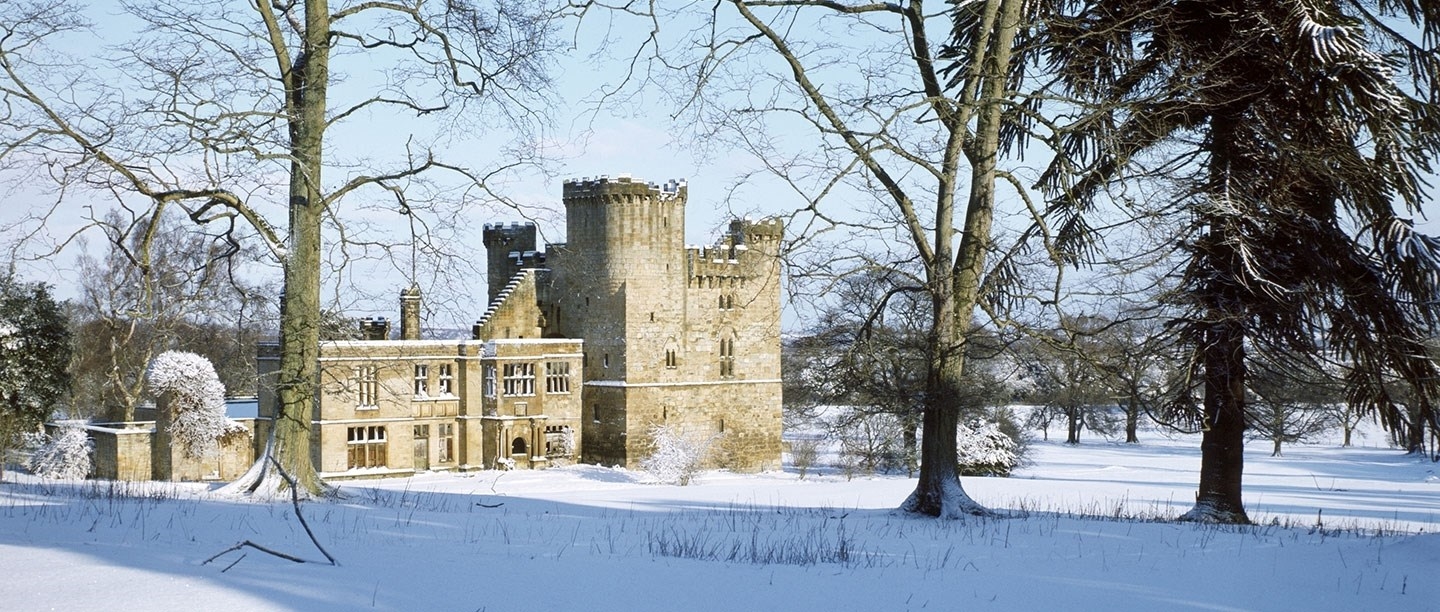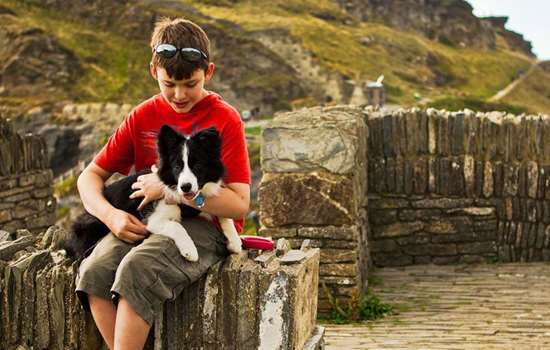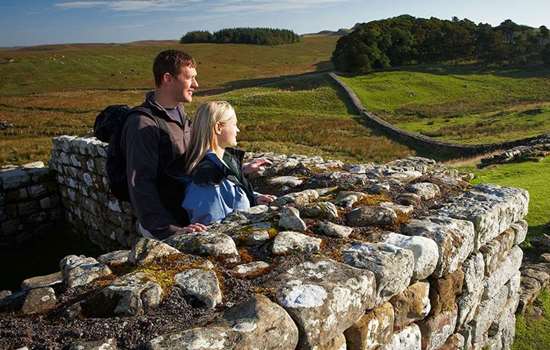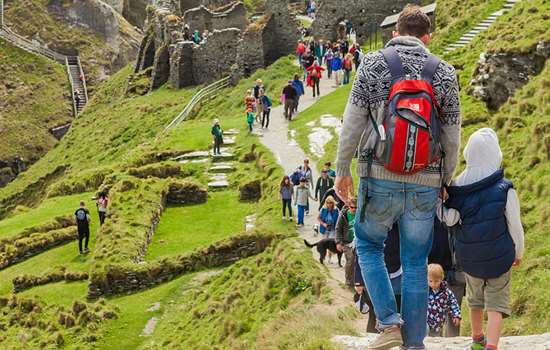Audley End House and Gardens
It's all about shape and structure at Audley End House and Gardens in the winter months. The house is set in a landscape designed by Capability Brown, there are the evergreen shrubberies to explore, and - in the kitchen gardens - the structure and shapes of the fruit trees are most evident. The branches are shaped into fans or espaliers, and frame the views across the garden to the glasshouses.
Close to the house, the form of the cloud hedge, is often accentuated with a covering of frost or snow, highlighting the intricate shapes of the yew and box plants. In late winter, snowdrops carpet the Lime Tree Walk and early daffodils appear as yellow jewels around the parkland.
Visit Audley EndBelsay Hall, Castle and Gardens
Wrap up and enjoy the delights of Belsay in winter.
You can't miss our impressive 28m Douglas fir, planted in the 1830s. And when it snows, we love showing-off our large Chusan palm (Trachycarpus fortunei). This adds an element of the exotic among the ice.
If you'd rather not brave the cold, you can take in the views of the garden from the warmth of the bedrooms in the house. This can be spectacular in the frost.
Snowdrops have a special meaning at Belsay. Lady Anne Middleton started a tradition in the early 18th century for the ladies of the house to plant snowdrops together. Join us in February to see the vast white carpets in the garden, fields and woodland surrounding the hall.
Visit Belsay HallBrodsworth Hall
The gardens at Brodsworth Hall have been designed for year-round interest - and there's plenty to enjoy in winter.
Discover the newly restored Victorian Privy Garden, which was designed to cover up the sight and smell of an outdoor loo.
A festive treat for garden-lovers is the Christmas rose (Helleborous foetidus), which comes into flower around Christmas. You'll also find Iris foetidissima, which produces bright orange berries against the backdrop of the winter-clipped yew hedge. The evergreens of the formal garden look their most dramatic during the winter, having been clipped through the summer. Their sharp lines and sweeping curves catch the eye at every turn, while the holly berries provide striking pockets of red, yellow and orange.
More than 500,000 snowdrops and 200,000 aconites will begin to flower, so it will be hard to miss them in late January. They'll cast a white and yellow blanket across the lawns and throughout the woodland.
Visit BrodsworthDown House
While most of the Down House garden rests in preparation for spring, look out for the orchids in late January and early February when they put on a show in the glasshouses. The air is scented by Osmoglossum pulchellum, a powerfully fragrant orchid from Central America which was studied by Charles Darwin.
Back outside, snowdrops and native daffodils provide colour and interest through the garden in the winter months. They should be in full bloom by late winter as the weather starts to warm up.
If you're feeling energetic, a walk around the wider garden and estate has many rewards. The gentle slope of Great Pucklands Meadow catches the winter sun, and the trees planted by Darwin on the Sandwalk now form a maturing woodland.
Visit Down HouseKenilworth Castle
In winter you can easily pick out the geometrical bed patterns within the Elizabethan garden. The 4.6m obelisks also provides structure. Obelisks were ancient symbols of power and immortality, and are an important feature of the gardens.
These gardens were designed for the pleasure and entertainment of Queen Elizabeth I in the 16th century. In 2009 we designed them as they would have looked.
When the sun shines, the birds can be heard singing in the aviary. Along its top cornice, see the 'great diamonds, emeralds, rubies and sapphires' described by household official Robert Langham in 1575 (read extracts from his letter describing the gardens here).
Visit KenilworthKenwood
The sweeping pasture and woodlands in Kenwood's grounds are picturesque at any time of year. They were designed by the great landscape designer Humphry Repton. This winter and early spring is an ideal time to visit, as the 200th anniversary of Repton's death will be commemorated in March 2018.
On cold mornings, walk around the ponds and woodlands and see them sparkle in the winter frost. Look out for the many veteran trees dotted about the estate. These include a majestic London plane tree which towers over the Service Wing - it's estimated to be between 250 and 300 years old.
Visit KenwoodOsborne
Winter is a great time of year to appreciate the structure of Osborne's avenues and the plethora of historic trees. Many of these were planted under the direction of Prince Albert in the 19th century.
The garden features many evergreen plants, which was fashionable in the Victorian era. Walk in Queen Victoria's footsteps through the pleasure grounds near the house and you'll find evergreens like rhododendrons and azaleas.
The Isle of Wight enjoys a mild climate, so look out for early flowering. We often have daffodils (such as Grand Soleil d'Or) flowering just before Christmas. If the weather is kind, primroses and native violets start flowering along the woodland walks down to the beach in February.
Visit OsborneWalmer Castle
With its close proximity to the coast and sheltered microclimate, Walmer Castle has one of the longest growing seasons and the shortest winters.
Discover the structural formality of the Queen Mother's Garden, including the topiary shaped as an 'E' for Elizabeth. Designed by Penelope Hobhouse, this garden was given to the Queen Mother in honour of her 95th birthday. The Queen Mother was Lord Warden between 1978 and 2002.
As you wander around the estate, keep an eye out for the early bulbs planted in pots around the garden. We expect these to start flowering as the days lengthen.
The yew of the cloud hedge will start growing early in the new year. For a few months over winter, its crisp flowing lines will provide structure and charm to the sleeping Broadwalk.
Snowdrops are becoming an increasing feature of our gardens here, with about 18,000 planted in the past three years. See them around the woodland walk, around the Oval lawn and in the Queen Mother's Garden.
Visit Walmer CastleWitley Court
The gardens at Witley Court are at their most striking during winter. The Cascade can be at its most spectacular at this time of year, particularly after heavy rain.
In the Wilderness Garden, enjoy the many winter flowering shrubs including hazel (Corylus), witch hazel (Hamamelis) and viburnums. Some of the early flowering rhododendrons can also surprise with a flash of colour along the Ornamental Walks in winter.
The Parterre gardens are equally dramatic. Here the clipped evergreen shapes from the mature topiaries and the outlines of the formal beds stand out on bright, clear days.
Don't miss the camellias growing in the ruins of the Orangery and a small winter garden containing the brightly coloured stems of dogwoods (Cornus).
Visit Witley Court



